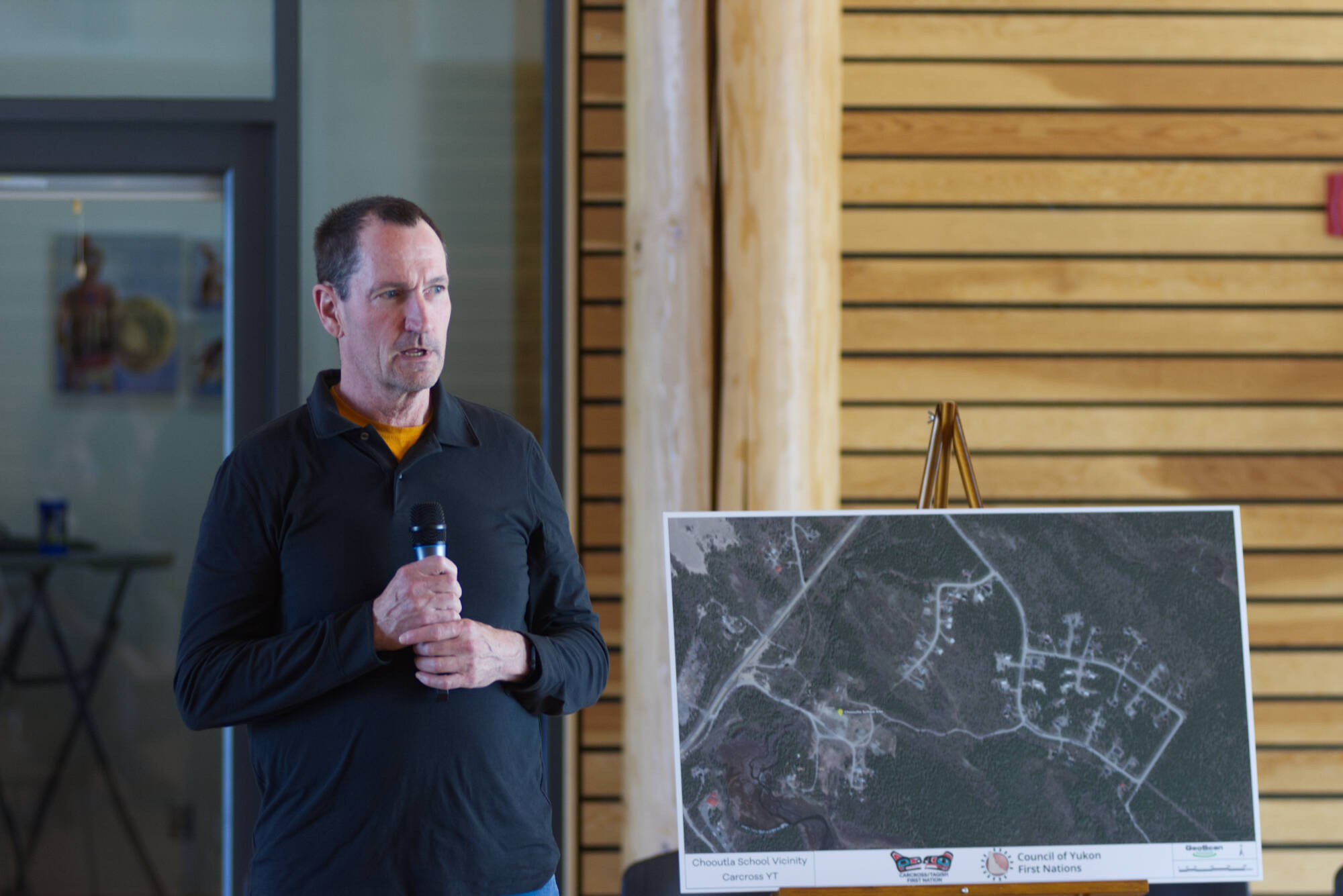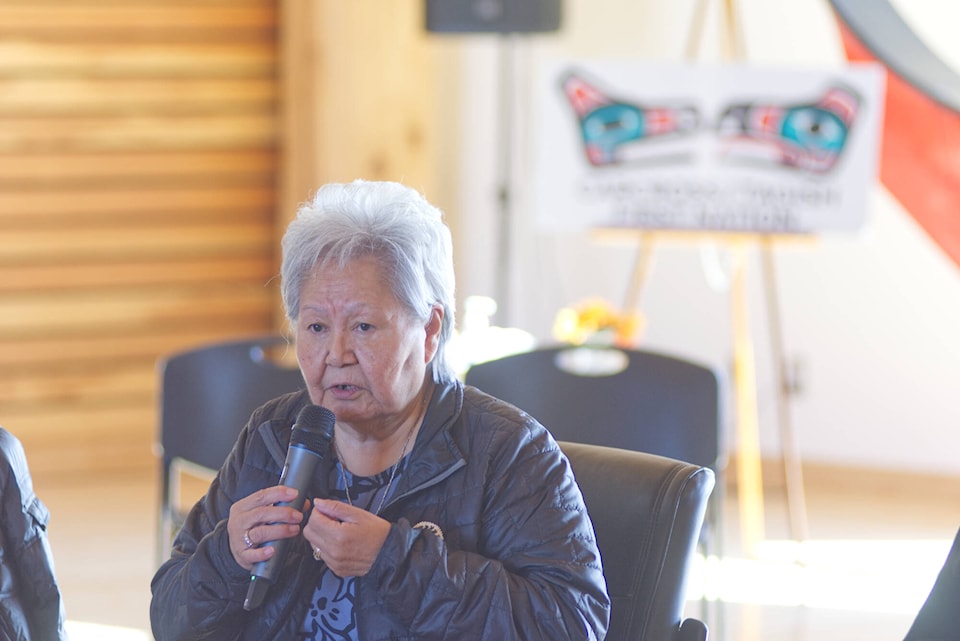The following story references abuse at residential schools. Yukoners can schedule rapid access counselling at 1-867-456-3838. The national Indian Residential School Crisis Line can be reached at 1-866-925-4419.
With work set to begin soon, combing the grounds of the now-removed Chooutla residential school in Carcross for unmarked and undocumented burials, the searchers are looking for local knowledge and expressing hope for local healing.
Brian Whiting, who works with GeoScan Subsurface Imaging Inc. was on hand to discuss the work with members of the community at Haa Shagóon Hídi, the First Nations Cultural Centre in Carcross on May 4 and 5.
“You know, given the history and legitimate grounds for distrust and anger, possibly, probably more than possibly, the fact that Ottawa is involved, the fact that government is involved, the fact that white people like me are coming in to do this work could lead some people to be suspicious or cynical or maybe just apathetic,” Whiting said.
“What I would say to respond to that is survivors are taking a front and centre role. Communities take a front and centre role. And that’s different, that gives a chance, I say chance because it’s really up to you, the chance to reclaim the narrative and you know, understand what happened out there.”
Whiting has participated in residential school site searches in other parts of Western Canada. Speaking about another school site, he described the affected community’s growing support for the project culminating in an emotionally intense but ultimately celebratory gathering with hundreds of people when the work was finished.
He detailed the tools of the trade, drones equipped with light detection and ranging (LiDAR) equipment and wheeled ground-penetrating radar units to be pushed over areas where unmarked graves may be.
Work will commence in late May with LiDAR drone flyovers. The ground crew is expected to start the following week.
Whiting said the school site alone is roughly 100 hectares in size so thoroughly mapping the site and then narrowing down the search area is important.
“We can’t cover very much ground in a given day, it’s a bit of slow work,” he said.
The search is informed by interviews with survivors and in some cases, archival research. This predictive work is important as Whiting said that even though the work at Chooutla alone is expected to take multiple field seasons, it will be impossible to pass the ground-penetrating radar device over the entire site. He said on other residential school searches he has worked on they have covered about 10 per cent of the whole site.
Along with limitations on the amount of ground that can be covered, technology limits what will actually be detected by the devices. An information handout passed to attendees at the May 4 event, states that unmarked graves are considered one of the most challenging objectives for this sort of subsurface detection work. Some reasons for this are human remains’ tendency to merge with the surrounding soil, the instruments’ inability to detect human remains or bones directly and the lack of a regular arrangement of graves as there might be in a formal cemetery.
The handout notes that some soil and groundwater conditions tend to preserve remains and graves while others do not.
Whiting added that generally, the farther north you go, the better the ground-penetrating radar works. He described challenges posed by the dense clay soil of places like the Vancouver area.
Community members who attended the meetings in Carcross were asked to place pushpins in an aerial photograph indicating areas they think should be searched. The first to do so was Lacey Ackland who lives near the former residential school site. She placed a pin in the photo near the trails that she walks on.
“That entire area has overgrown trails and some of the trails that I personally walk around you can feel the really heavy energy where the trees are holding history, information, it’s almost like a secret,” Ackland said.
She said some trails are still well utilized today but some are overgrown suggesting they have been there for a long time.
Whiting replied that a portion of the research prior to work on the ground at the Chooutla school site has been finding all available aerial photos of the area, some from as far back as the 1930s. He said trails are evident on some of the old photographs.
“People are not going to just walk through impenetrable woods to secretly bury somebody. They’re going to use existing trails, so certainly that’s a good clue right there. Where were those trails in the past and can we use those to identify some places to look?”
Also speaking to the people in Carcross were Adeline Webber and Judy Gingell, the chair and vice chair of the Yukon residential schools missing children working group. The group initially set out to search the grounds of the Chooutla school but now plan to expand the work to the rest of the residential school sites in the territory and beyond. Sites in Whitehorse, Dawson City and near Aklavik, Northwest Territories will be the subject of future efforts.
“What we’re doing today, it just makes me feel good that we finally can get out to the communities and also get them further debriefed and update them as to as to what it is we’re doing,” Gingell said.
She added that the working group plans to visit two more Yukon communities in the near future to hear from residential school survivors and other community members there.
The federal and territorial governments have provided financial support for the search projects in the Yukon and Webber said there has been a fruitful sharing of information with other communities across Canada conducting their own searches. An Outside organization called Know History, has been engaged to comb through records to help inform the Yukon searches.
“People are saying that there’s graves out there of our little children. We have a duty and responsibility to go out there and check this out and find out you know where they’re at. Our job is to find out where those little babies, those little children are at to bring peace back to our people and into our communities,” Gingell said.
Contact Jim Elliot at jim.elliot@yukon-news.com

